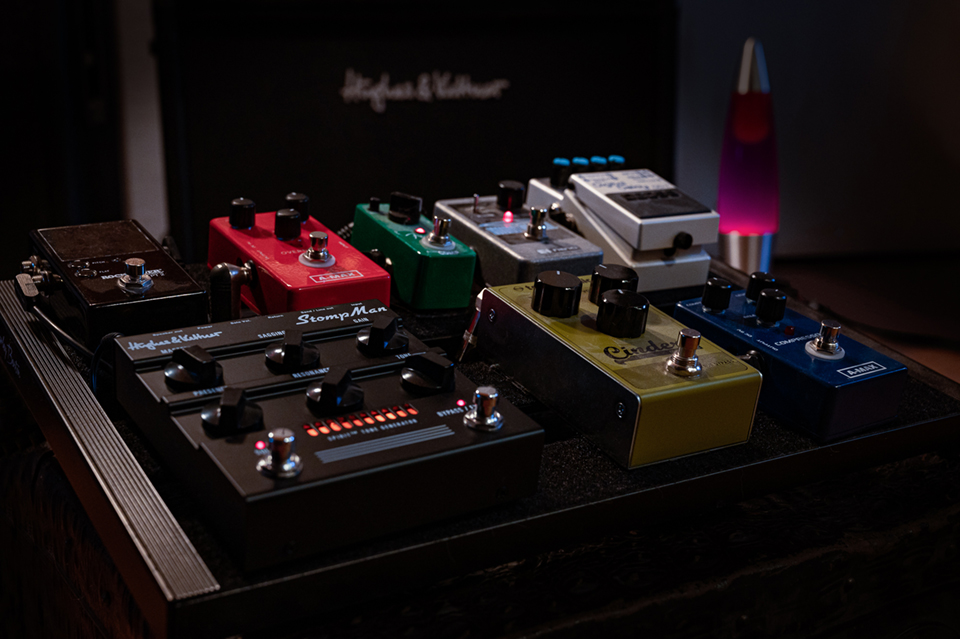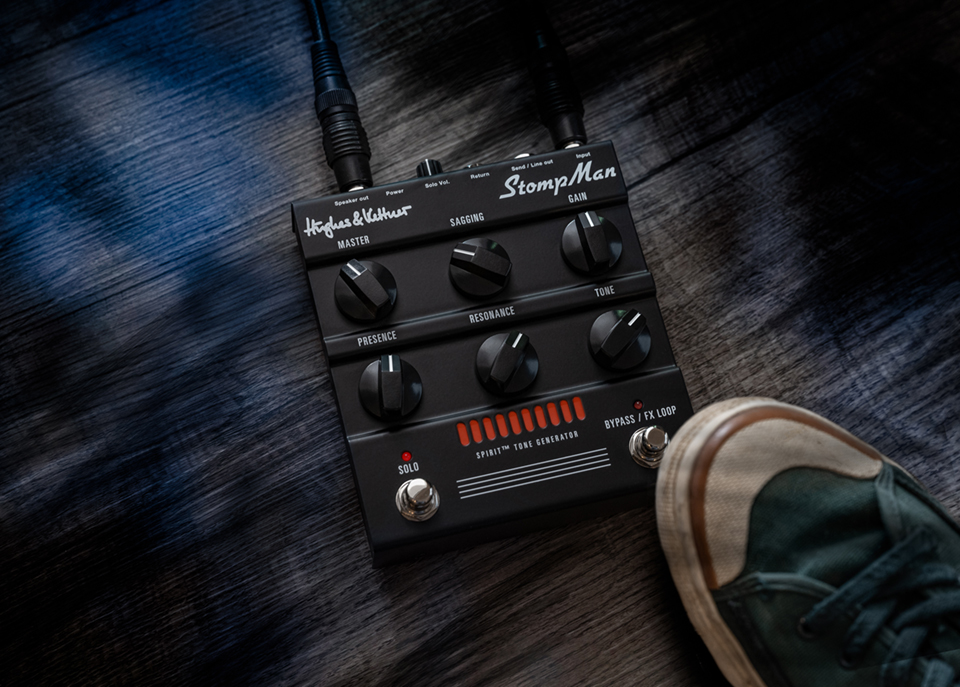When the Hughes & Kettner company introduced the Spirit Tone Generator a few years ago together with their BS 200 series, a worldwide murmur went through the scene. Never before it has been possible to get so close to the sound of a vacuum tube with a transistor amplifier. Due to the patented, purely analogue circuit, the amplifier managed to bridge the gap between the light, inexpensive but also poorly-sounding transistor amplifiers to the top league of all-tube amplifiers in terms of sound, which unfortunately also have a high transport weight and, due to their components, have a significantly higher price .
It was immediately clear to me that this part would be a box office hit, but even I didn’t expect the immense success of this amplifier series. Other products such as the Nano Heads or the AmpMan followed and, with the help of the Spirit Tone Generator, were able to deliver a significantly higher quality sound than what the retail price would suggest. But Hughes & Kettner wouldn’t be Hughes & Kettner if they weren’t constantly striving to expand and improve their portfolio, which is why the latest addition to the Spirit Tone Generator family is called StompMan and again comes with a number of very well thought-out and extremely practical ones Features would come up.

The structure of the Hughes & Kettner StompMan
The experienced reader will probably be able to guess for which application the Hughes&Kettner StompMan was designed after just a quick look at the layout of the amplifier in combination with its name. The dimensions of just (W x D x H): 132 mm x 52 mm x 153 mm and the weight of 650 g suggest that the amp was designed for floorboard use. In order to be able to operate the amp, on the other hand, the included power supply unit must be used, since the performance characteristics of 24 V and 2.5 A cannot be supplied by any multi-voltage power supply unit that is normally used in floorboard operation. But the whole thing shouldn’t be a real problem, since the power supply was designed to be relatively flat and narrow and should therefore fit under most floorboards beyond the Nano / Mini series with 2 cable ties or the like. The power supply works worldwide due to its voltage processing of 100 – 240 volts.
The concept of the amplifier, designed as a single channel, is based on the AmpMan, which is characterized in terms of tone control by dispensing with a three-band tone control in favor of a tone controller. In addition to the master volume and the gain controller, the Hughes&Kettner StompMan offers three controllers from the power amp area, which are divided into the areas of resonance, presence and sagging. The sagging controller in particular is a unique selling point, as it emulates the saturation behavior of a tube power amp and can play to its strengths, especially in the crunch area.
The amp delivers 25 watts into 8 ohms, which is more than enough for a regular club gig. Since it is a transistor output stage, the power output varies depending on the impedance of the box, i.e. the amp offers almost 12.5 watts at 16 ohms, but 50 watts at 4 ohms. The Hughes&Kettner StompMan offers 2 footswitches, a solo switch with which the output level can be increased by up to +6 dB (adjustable via a potentiometer on the front) and a bypass switch whose function can be combined on the front with a mini switch FX-Loop toggle switch and we will go into its exact function in a moment.
The design of the amp The Hughes & Kettner StompMan, with its single-channel orientation in the stand-alone function, is based on the “more-or-less-clean” and distorted sounds of the 60s and early 70s, which can be found as a house number in the JMP and JCM area, or to put it another way, Clean is done with the volume control of the guitar and lead / high gain with an overdrive / distortion pedal connected in front of it. The gain range was designed to be rather moderate and focuses more on the power amplifier work, which can be varied very well with the sagging controller even at low volumes. If bypass is activated, gain and tone are taken out of the signal path, but presence, resonance and sagging are still available and deliver finely controllable tube power amp sound. So far everything is fine, but that alone would not necessarily be a strong argument for the amp, so we now come to the application examples of the amp!
The application examples of the Hughes&Kettner StompMan
Unlike guitarists who need a modeller as an “all-in-one” solution, a typical pedal board player mostly wants a modular solution where they can express their individuality using their personal pedals. He may also want to connect additional preamps and, depending on the area of application, use separate speaker emulations for direct to FOH or in-ear applications and may also use external noise gates. Here the StompMan can help with a comparatively simple but ingenious setup:
1.) As a full-fledged single-channel amp
Use with booster, fuzz, overdrive, chorus, flanger etc. in front of the input, and reverb or delay effects in the loop is the main application of the Hughes&Kettner StompMan. Here the StompMan is used like a classic single-channel amp including pre- and power-amp sound parameters with a guitar box, with the convenience of a switchable FX loop and a clever solo function to relieve the FOH .
2) As a power amp (bypassing the internal preamp)
Thanks to the integrated bypass, the user does not need to “abuse” the FX return to bypass the internal preamp so that external preamps can be boosted. Bypass removes gain and tone from the signal path, the power amp sound parameters presence, resonance and sagging as well as the FX loop can still be used. To adjust the input level of the StompMan to the output level of the connected preamp, the StompMan offers a trim pot on the underside.
3) Recording via FX Send/Line and Software Cab-Sims
Whether with or without ballasts or preamps, the StompMan output labeled “FX Send / Line” picks up the signal directly in front of the master, so it already contains presence, resonance and sagging. Ideal for going into the line input of the DAW and using software cab sims and effects.
4) In Ear / Direct to FOH / FRFR
Appropriate hardware cab sims can be used for direct to FOH or in-ear applications. Instead of going into the return of the StompMan, at the end of the signal chain you simply go into the input of the Cab Sim and from its output to the console. It is still possible to use the power amp of the StompMan: if you connect the output of the Cab Sim to the return of the StompMan, its power amp amplifies the full-range signal of the Cab Sim FRFR boxes can be operated at the speaker-out of the StompMan.
The Hughes&Kettner StompMan in practice
In the practical part, I concentrated on the stand-alone operation of the amp, since the sound effects of external pedals would change the sound of the amp too much. The first thing that strikes you once again is that the tone control actually makes 80 – 90% of all three-band settings superfluous. On the contrary, the risk of an incorrect setting is massively reduced. Left stop has the typical British mid boost, right stop has a typical scoop alignment, everything in between is infinitely adjustable.
As with the big example of the Hughes & Kettner StomMan (I guess it’s supposed to be a 2203), the tonal effectiveness is kept very moderate, i.e. even with long control paths the change in sound remains moderate. So you can z. B. like to set the Resonance control to the right stop without causing a lot of pumping, but that’s exactly what makes u. the sonic appeal. Once again you have to keep in mind that this is not an all-tube amp, because the analog circuitry in combination with the sagging control makes it really difficult to filter out the difference in sound. The amp is highly dynamic, hangs very well on the guitar’s volume control and offers the perfect basis for classic riffing in blues, rock and traditional hard rock.
For the American clean sound, the Hughes&Kettner StompMan also offers very variable options, for example I was very impressed by a clean gain setting with a strong sagging component. To hear the sagging effect in an A/B comparison, I recorded the same riff with and without sagging, the result speaks for itself. In conclusion, the StompMan can only be given top marks. The amp convinces with tiny dimensions with a very good sound, which is really, very close to the originals in the style of a 2203 or 2204, but has a significantly higher circuit flexibility, which again significantly increases the portability.
Hughes&Kettner StompMan – Clean
Hughes&Kettner StompMan – Crunch 1
Hughes&Kettner StompMan – Crunch 2
Hughes&Kettner StompMan – Humbucker No Sagging
Hughes&Kettner StompMan – Humbucker With Sagging
Conclusion
With the Hughes & Kettner StompMan, the German company has landed another big hit. The excellent-sounding amp impresses with a clever concept, which puts it in the front row of working musicians in terms of transportability and flexibility.
If you want to get the maximum sound out of your floorboard, you should definitely try the amp.
For further information about the amp, please check out THIS LINK and check your language at the upper right corner.
GET YOUR BEST PRICE AT MUSIKHAUS THOMANN OR AT AMAZON
Written by Axel Ritt for Neworleansmusicians.com
Neworleansmusicians.com Podcast can be found on these platforms.



















